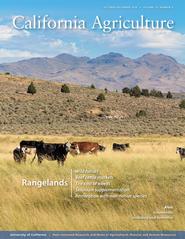All Issues

Cattle graze in Lassen County. Rangelands cover between 31 and 57 million acres in California, depending on how “rangeland” is defined. This issue features articles on auction markets for beef cattle, wild horses, selenium supplementation, rangeland weeds and restoration practices. Photo by Will Suckow.
Editor Jim Downing talks about what's in the current issue of California Agriculture journal — wild horses, the economics of beef, groundwater in California and more.
Volume 70, Number 4





